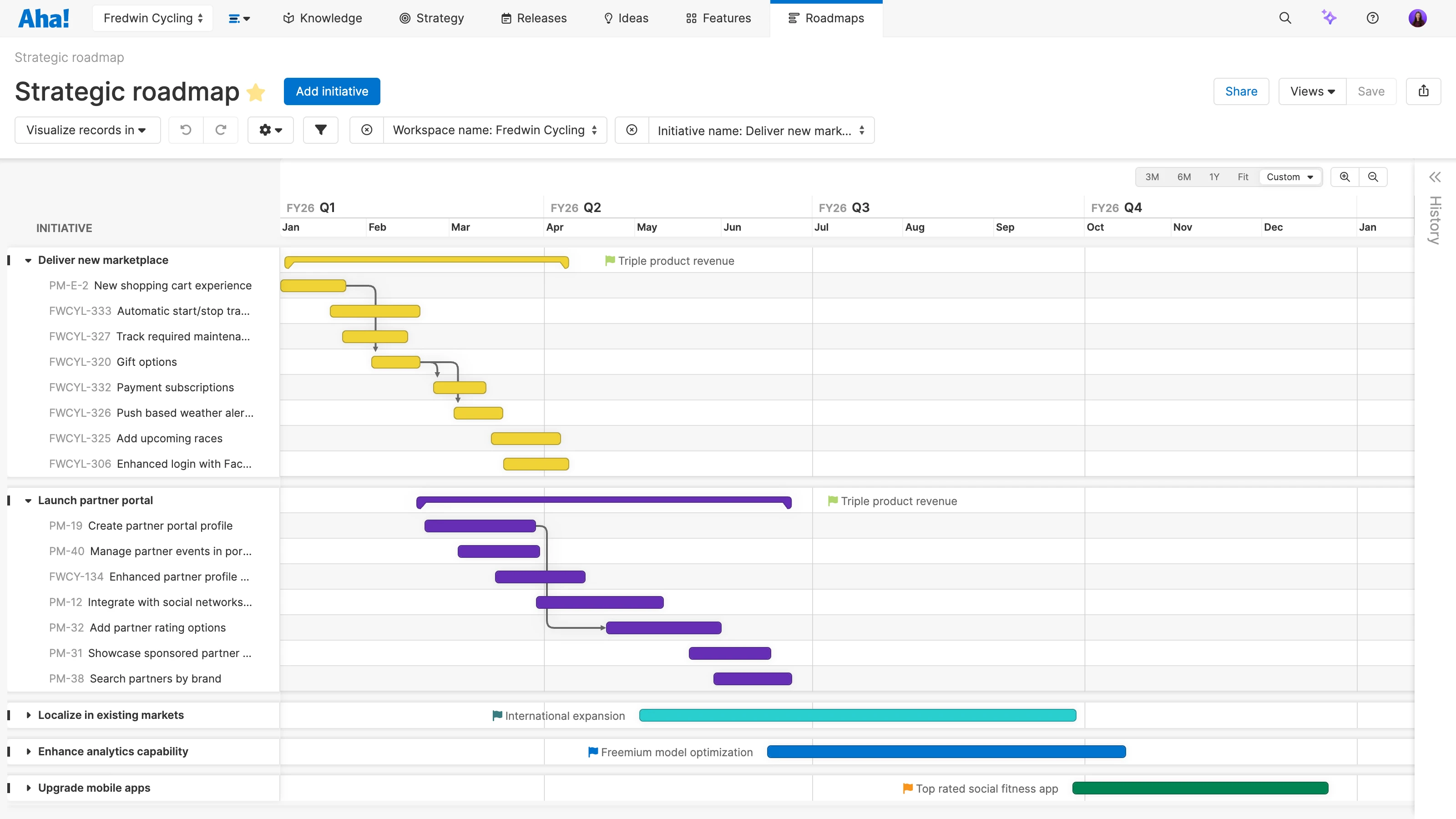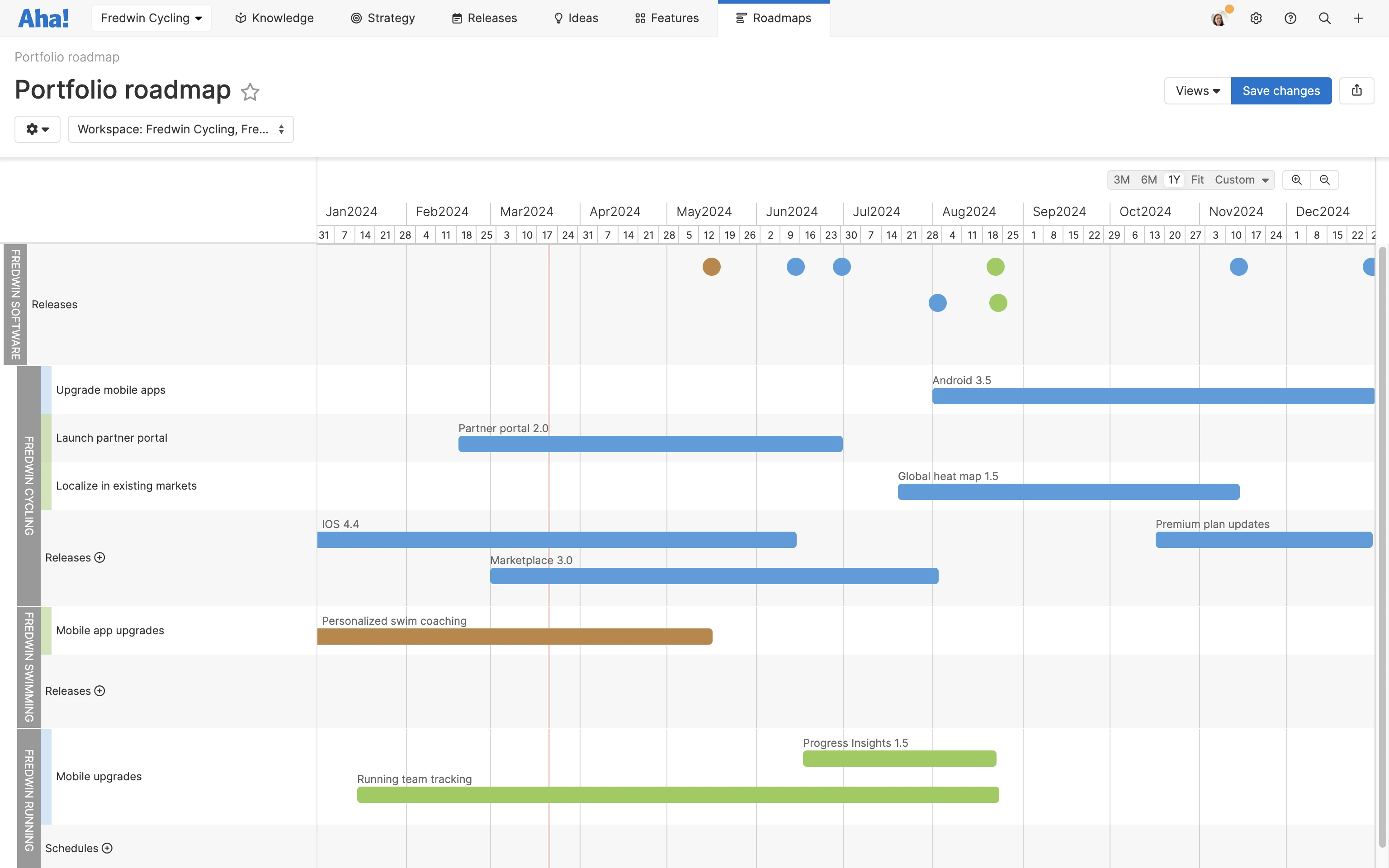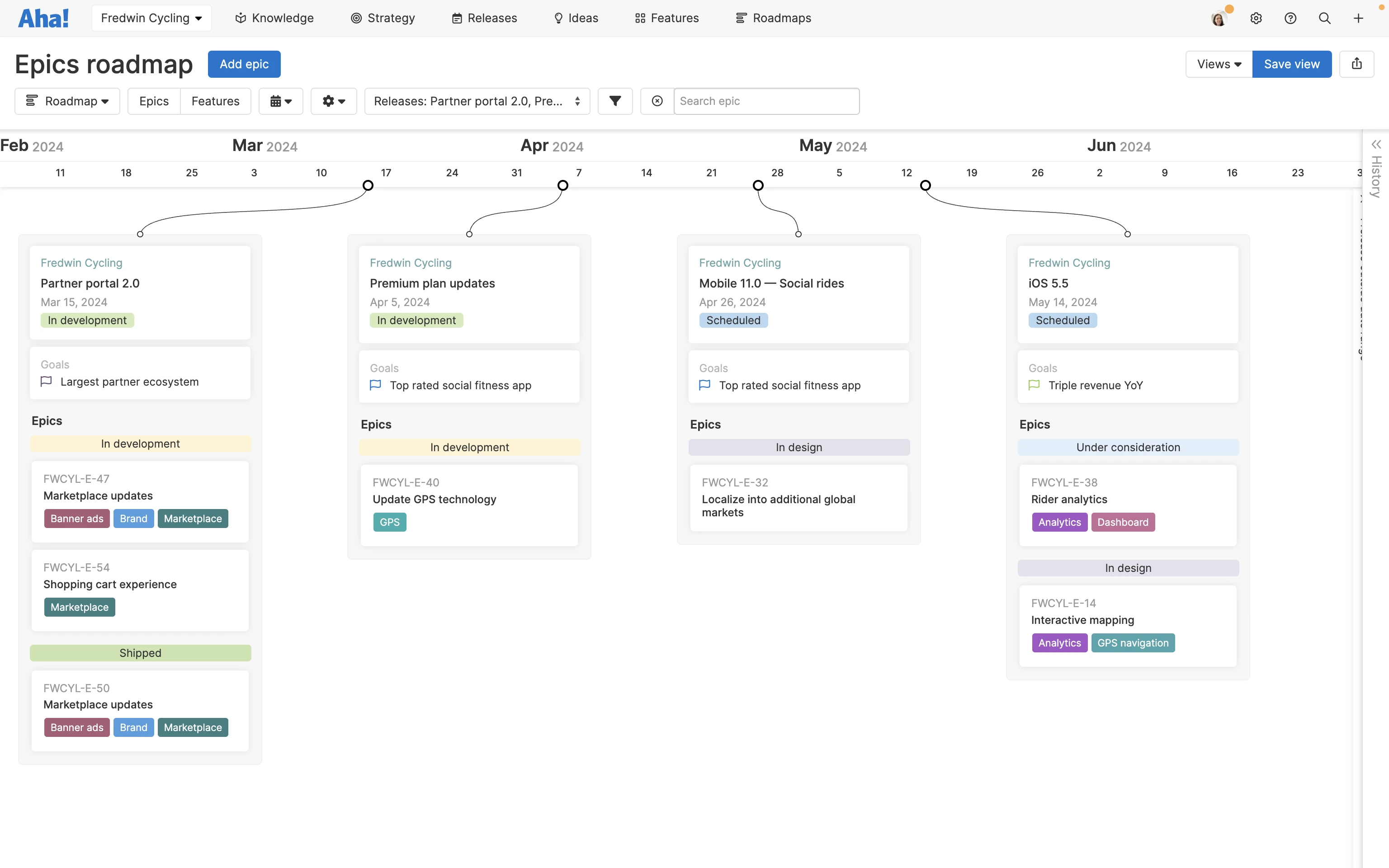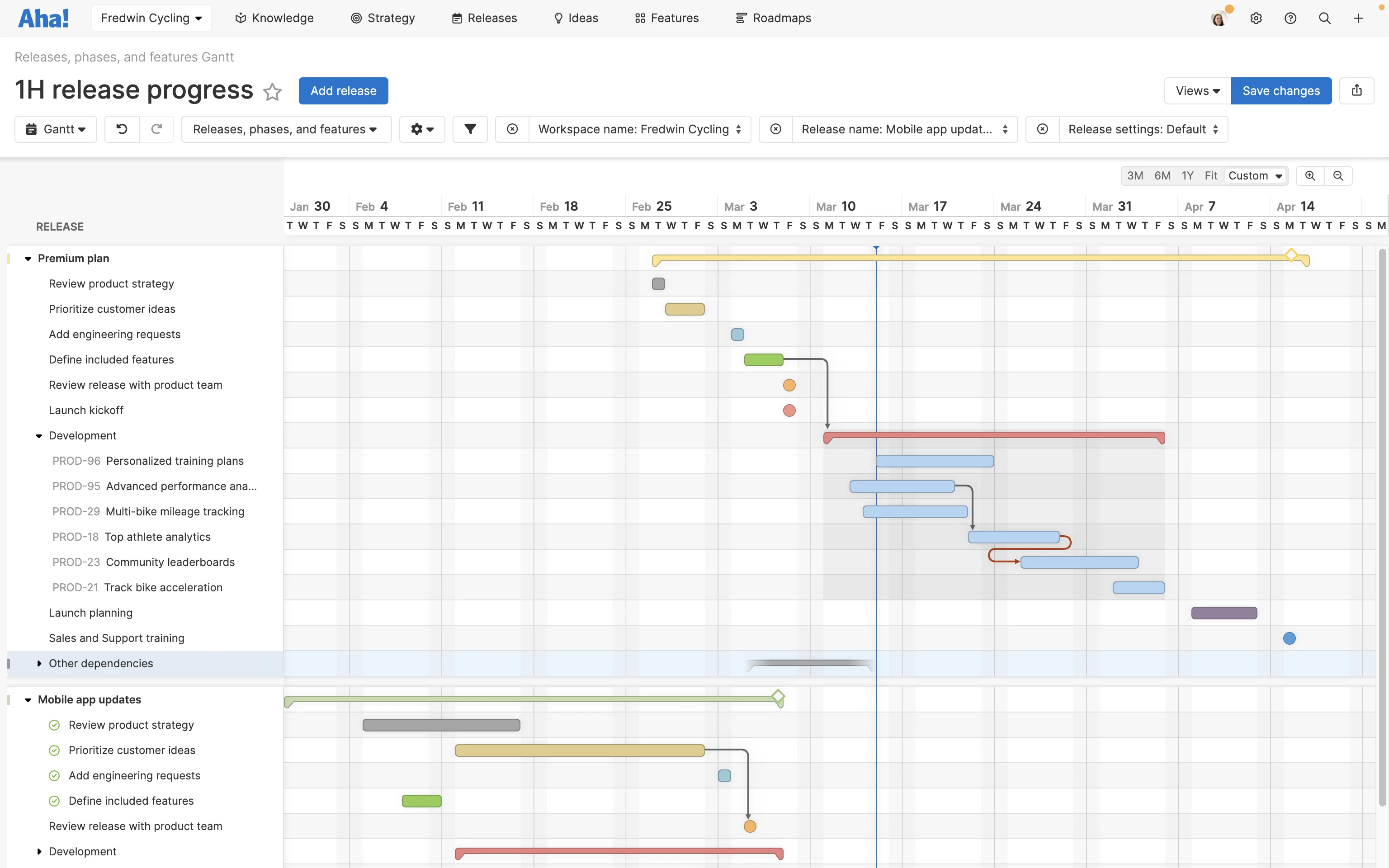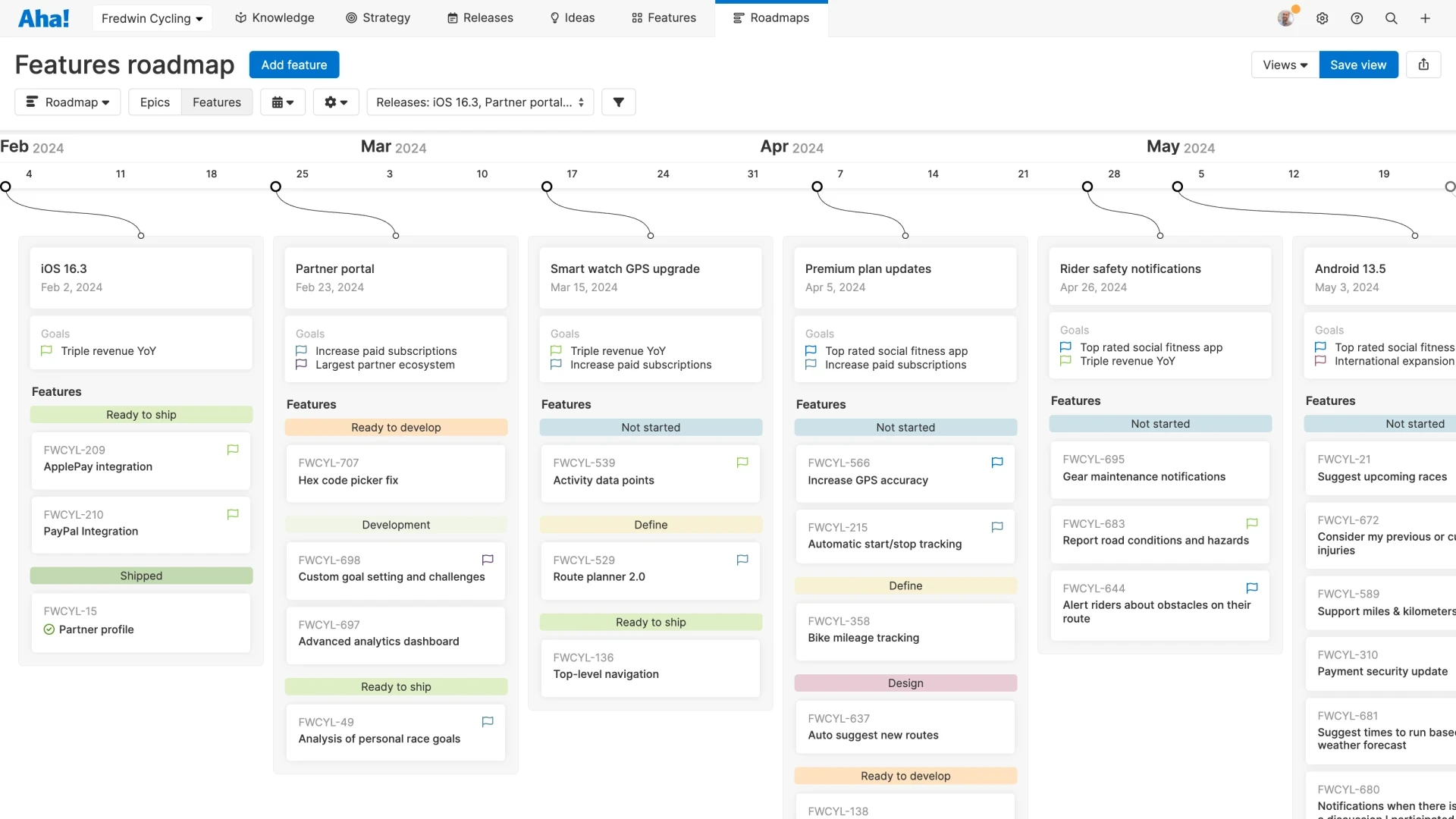Visual product roadmap examples for product teams
Last updated: March 2024
A visual product roadmap is much more than a to-do list of upcoming tasks. It captures your high-level product direction, shows the work you will do to achieve your goals, and displays it all on a timeline for completion. Your product roadmap also communicates progress and shows how the work of the entire product team contributes to the overarching strategy.
Build a visual product roadmap in Aha! Roadmaps — free for 30 days.
Most product roadmaps include the same components, but you must consider a number of factors to build the right kind of roadmap — like your audience, the purpose of the roadmap, level of detail, and time frame. In this guide, we will explore six common visual roadmap examples to help you build the right visualization for the right situation.
Jump ahead to explore any section in this article:
What is a visual product roadmap?
A product roadmap helps you communicate your product vision — putting product plans in action. It outlines your high-level goals and initiatives, releases and features that support them, and a timeline for implementing all of the work.
The best product roadmaps provide clarity on your product vision and strategy — creating a link to the features you deliver to customers. That means you must invest time in developing your strategy first. Then your product roadmap should convey your plan for accomplishing your strategic goals and initiatives. It should ultimately highlight the "why," "when," and "what" of your product plans.
Your visual product roadmap should be accurate, actionable, and visually appealing. It should also incorporate input from customers, stakeholders, and teammates. For efficiency, it is best to use a dynamic roadmap instead of static diagrams or spreadsheets. That way, the most up-to-date information is automatically presented as plans change.
Related:
Why you need multiple roadmaps
With all the considerations that go into a product roadmap, it can be tricky to present the right details. A single product roadmap — even if it is a great one — might communicate only some of the essential product data, quickly become inaccurate or outdated, or fail to deliver the right information for its intended audience. Product managers often need to build multiple product roadmaps to tell the whole story. Having multiple product roadmaps also allows you to be flexible so you can easily pivot and adjust views when necessary.
Remember that product roadmaps are not inherently effective. They are only as useful as you make them. It is up to you to create (and commit to) product roadmaps that will help you achieve exceptional results.
Related:
6 product roadmap examples
Beautiful product roadmaps rally your product team around the most important work and clarify why your efforts matter. And beyond your core team, compelling product roadmaps help to generate excitement and buy-in from executives, cross-functional teammates, and customers.
Below are six examples of visual product roadmap templates to inspire you when building your own. Each example displays similar information but presented in a different way, highlighting certain elements and minimizing others. We will start with high-level views and show more detailed roadmaps with each example.
All of these product roadmap examples can be adapted to your fit your team's preferences, product type, and development methodology. For instance, an agile product roadmap would closely resemble these examples — with the differences reflected in your goals, approach to planning, and willingness to work in iterations.
1. Goals roadmap
A goals roadmap shows the big picture. It outlines your measurable, time-bound objectives and the plan for when the team will accomplish them. The example below includes a success metric and progress bar next to each goal so you can quickly see the impact of your efforts. On the monthly timeline, strategic initiatives display the large themes of work that will contribute to each goal.
An example of a goals product roadmap created in Aha! Roadmaps
2. Strategic initiatives roadmap
Strategic initiatives are the high-level efforts you are pursuing to achieve your product goals. In the product roadmap example below, each initiative is linked to a corresponding goal. This is similar to the information displayed on the goals roadmap but the focus is placed more on the individual initiatives. In this view, you can also expand each initiative to show the relevant product releases underneath — providing an extra layer of detail.
An example of a strategic initiatives product roadmap created in Aha! Roadmaps.
3. Portfolio roadmap
To show planned releases across multiple groups or products within an organization, try a portfolio roadmap. In this view, the product portfolio is at the top, with two software products underneath. You will also see dots representing important dates for specific release milestones. Even with multiple products, initiatives, and release timelines, you can display everything clearly on a single product roadmap.
An example of a portfolio product roadmap created in Aha! Roadmaps
4. Epics roadmap
Epics help you organize upcoming work by grouping related features under one umbrella that may span multiple releases. The product roadmap example below shows a shorter-term view of upcoming releases with associated goals and epics. Epic roadmaps like this are useful for communicating key focus areas. This helps you make prioritization decisions when you do not need to display every individual product feature that is in the works.
An example of an epics product roadmap created in Aha! Roadmaps
5. Releases roadmap
This product roadmap helps to visualize what needs to happen in order to deliver upcoming releases on time. With your releases displayed on a visual timeline, you can view the full scope of ongoing work and drill into specific features. You might also include milestones to show important dates like deadlines or approvals. The gray arrows indicate dependencies, making it easy to identify blockers or constraints that need to be resolved for on-time delivery.
An example of a releases product roadmap created in Aha! Roadmaps
6. Features roadmap
A features roadmap communicates the details of what is coming and when. The example below shows a quarterly view with each swimlane representing a different release. Within each release is the full list of planned product features to be delivered. Grouping features by status — such as "Under consideration," "Ready to develop," and "Shipped" — visually highlights the state of progress. And once again, everything is linked back to an overarching goal.
An example of a features product roadmap created in Aha! Roadmaps
Every product needs a plan and every product plan needs a roadmap. If you are ready to start creating stunning product roadmaps, consider investing in purpose-built roadmapping software. Roadmapping software helps you create, customize, and share professional product roadmaps in minutes. You can choose from a variety of templates and tailor the visual details to your needs — so you can take pride in every product roadmap you build.

